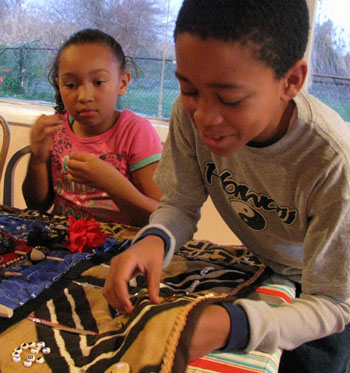
 |

|

By CATHERINE KRIKSTAN
Capital News Service
Friday, December 4, 2009
GRASONVILLE - From building boats and making sails to owning seafood restaurants and processing plants, black watermen have, for more than a century, made contributions to the culture of the Chesapeake Bay.
But their narrative remains largely unwritten, alive above all in oral histories, old photographs and now, a quilt.
Joan Gaither, a professor at the Maryland Institute College of Art, creates quilts that document stories, and was inspired to create one that shares the unrecorded tales of the region's black watermen.
"I think (it) is absolutely criminal that all of these voices have not been heard," Gaither said.
"I'm on a mission. And it's an urgent mission, because the people who hold this information -- the images, the artifacts, the stories -- are dying off, and I need to get to these folks ... post haste," said Gaither.
Hundreds of people have shared a stitch on the quilt at public quilting sessions, which have allowed Gaither to collect stories from the community.
"The color of your skin, your age -- it doesn't matter. It's about sharing stories," Gaither said.
"This is not a black thing. This is not a white thing. This is a thing thing, you understand? Everybody's invited -- it's everybody's history," said Gaither.
One session, in Grasonville, brought out several boat captains and their families.
There was Agnes Washington, 90, whose father was a waterman and whose brothers crafted sails for men like Jackie Gleason and Johnny Carson. There was Lamont Wright, a boat captain who sang a song inspired by the water with his mother, Shirley. And there was Tyrell Jamerson, 11, who fishes on his grandfather's boat and who sewed onto the quilt the names of bay fish, like croaker and perch.
"Quilts were really meant to just keep you warm and to protect, and they were made from samplings of fabric that people could relate to," Gaither said. "I decided that I wanted to do more than that -- I wanted them to hold the stories of the people."
Gaither embellished this quilt, which will begin a national tour with more of her work this month, with symbols that are relevant to the black waterman story: mud cloth from Africa, pieces of a life preserver made to look like a lighthouse, and oyster shells and fishing lures.
As the bay undergoes changes, so, too, does black waterman culture.
"African American watermen aren't encouraging future generations to pursue that trade," said Vince Leggett, who directs the Blacks of the Chesapeake Foundation and who collaborated with Gaither on creating the quilt.
"For many African Americans, there are increasing opportunities to move into other fields, where at one time it was just so limited," Leggett said.
These watermen are becoming charter boat captains or marine contractors and construction workers.
"That way, they can still use their boats. They still have independence. They still rely on time and tide to guide their day," said Leggett.
And they still possess "the pieces and the parts" of the black waterman story, Gaither said.
"I'm hoping that from these quilts ... (people will be) empowered to invest in their own stories and to document them. They're excited about it. They really feel like it's important. For me to be able to do that -- encourage that -- makes me really happy," said Gaither.